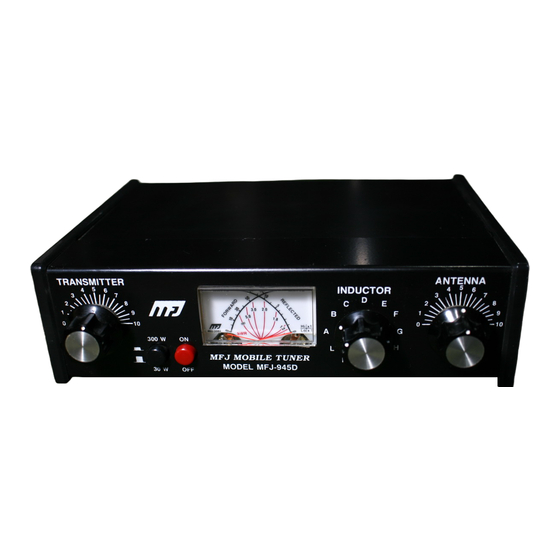
Advertisement
MFJ-945D
Instruction Manual
MFJ-945D Mobile Tuner
Instruction Manual
Introduction
The MFJ-945D tuner is a 300 watt PEP output (175 watts on 160 m) antenna tuner. It is
designed to match 50 ohm output amplifiers, transmitters or transceivers to an antenna in a
mobile installation.
Forward power, reflected power, and SWR are displayed on the
wattmeter's illuminated cross-needle meter.
The MFJ-945D uses a "T" matching network. It continuously tunes all frequencies from 1.8
through 30 MHz. It will match dipoles, inverted-vee's, verticals, mobile whips, beams, random
wires, and many other antennas. The MFJ-945D has a single connector for coaxial output.
SWR/Wattmeter
The cross-needle meter measures the peak or average FORWARD power, REFLECTED power,
and SWR. The meter's full scale forward and reflected power range is controlled by the left
POWER switch that selects 300W (HI) or 30W (LO). If your transmitter runs more than 30
watts of output power, set this switch to the 300W HI (in) position. If your transmitter has less
than 30 watts of output, set this switch to the 30W LO switch position (out).
Forward power is displayed on the left-hand FORWARD meter scale. This scale is calibrated
from 0 to 30 watts and is read directly in the 30 watt position. In the 300W (HI) position the
forward power scale must be multiplied by 10. Reflected power is read on the right-hand
REFLECTED meter scale. This scale indicates 5 watts full scale when the 30W power
sensitivity is selected, and 50 watts full scale when the 300W power scale is selected. This
scale is also multiplied by 10 when using the 300W power position.
The most accurate power readings occur in the upper half of the meter scales. When trying to
measure power with a less than perfect match, the reflected power should be subtracted from
the forward power readings.
The SWR is read directly from red SWR curves that range from 1:1 to infinity. SWR is
measured by observing the point where the forward and reflected power needles cross. The
SWR is indicated by the red curve closest to the needle crossing point. No cumbersome or time
consuming SWR sensitivity adjustments are required with this meter.
The wattmeter has an internal lamp that backlights the meter scale. The lamp circuit requires
power from an external 12 Vdc source. The rear panel jack accepts a 2.5 mm plug with a
positive tip polarity. The negative lead is grounded inside the tuner. The METER LAMP ON /
OFF switch turns the meter lamp off and on.
1
Advertisement
Table of Contents

Summary of Contents for MFJ 945D
- Page 1 MFJ-945D Mobile Tuner Instruction Manual Introduction The MFJ-945D tuner is a 300 watt PEP output (175 watts on 160 m) antenna tuner. It is designed to match 50 ohm output amplifiers, transmitters or transceivers to an antenna in a mobile installation.
- Page 2 MFJ-945D Instruction Manual Interconnections...
-
Page 3: Installation
Using The MFJ-945D CAUTION: Never Change The Antenna or Inductor Selector Switch Position While Transmitting! Never Apply More Than 300 Watts To The MFJ-945D. In any conventional "T" network tuner, maximum power handling and smoothest tuning occur when the capacitance in the network is as large as possible. In this tuner the TRANSMITTER and ANTENNA controls have maximum capacitance at position 0 (fully meshed), and minimum capacitance at position 10 (fully open). -
Page 4: Adjustment Procedure
Note: Do NOT change the transmitter's tuning (plate) or loading (antenna) controls until after the tuner has been fully adjusted. The transmitter can be "touched up" after the MFJ-945D is fully tuned. Set the GROUND MATCHING controls at zero (maximum capacitance) and "L" (minimum inductance) unless you already know the correct position for the band you are using. - Page 5 MFJ-945D Instruction Manual 4. Carefully adjust the "TRANSMITTER" and "ANTENNA" MATCHING controls for the lowest reflected power. NOTE: These controls interact. Adjust the TRANSMITTER control for minimum, then adjust the ANTENNA control for minimum SWR. Go back and forth between these adjustments as many times as required until the lowest reflected power (best SWR) is obtained.
-
Page 6: In Case Of Difficulty
300 watts PEP (175 watts on 160 meters). The MFJ-945D will reduce the SWR of most antenna systems to 1:1. In some cases, a perfect 1:1 SWR may not be obtainable. If this is the case, the length of the antenna or the feedline can be changed slightly until a low SWR can be obtained. -
Page 7: Antenna System Hints
For operator safety a good outside earth ground or water pipe ground should always be installed and connected to the case of the MFJ-945D. Make certain the safety ground also connects to the transmitter and other station accessories. A wing nut post marked GROUND is provided for ground connection(s). -
Page 8: Technical Assistance
MFJ toll-free at 1-800-647-TECH (8324). Outside of the continental USA. call 601-323-5869. You will be best helped if you have your unit, manual and all information on... - Page 9 MFJ-945D Instruction Manual You can also send questions by mail to MFJ Enterprises, INC., PO. Box 414, Mississippi State, MS 39762; by FAX to 601-323-6551; through Compuserve at 76206.1763; or by email to 76206.1763@Compuserve.com. Send a complete description of your problem, an explanation of exactly how you are using your unit, and a complete description of your station.














Need help?
Do you have a question about the 945D and is the answer not in the manual?
Questions and answers